Here are the main results on gravitational waves/B-modes from the CMB, as reported by the BICEP2 experiment. For background see my previous post. All of the BICEP2 results and plots are here.
First, the best fit to r, the ratio of gravitational waves to density perturbations:
Rumors were right, and r = 0.2 is the best fit (with errors plus .07, minus .05). Here is the power spectrum (amplitude as a function of angular scale on the sky):
And here we have the contours in r/nS space, analogous to the Planck constraints we showed yesterday. Note that this plot crucially allows for “running” of the spectrum of density perturbations signal — the size of the fluctuations changes in a more complicated way than as a power law in wavelength. If running weren’t included, the different constraints would seem more incompatible.
Comparison with other limits (BICEP2 results are black dots at bottom):
Finally, here is a map of the actual B-mode part of the signal:
Overall, an amazing result (if it holds up!). It implies that the energy scale of inflation is about 2×1016 GeV — pretty close to the Planck scale (2×1018 GeV). An unprecedented view of the earliest moments in the history of the universe.
[From earlier.] Here is an email from BICEP2 PI John Kovac:
Dear friends and colleagues,
We invite you to join us tomorrow (Monday, 17 March) for a special webcast presenting the first results from the BICEP2 CMB telescope. The webcast will begin with a presentation for scientists 10:45-11:30 EDT, followed by a news conference 12:00-1:00 EDT.
You can join the webcast from the link at http://www.cfa.harvard.edu/news/news_conferences.html.
Papers and data products will be available at 10:45 EDT from http://bicepkeck.org.
We apologize for any duplicate copies of this notice, and would be grateful if you would help share this beyond our limited lists to any colleagues who may be interested within our CMB and broader science communities.
thank you,
John Kovac, Clem Pryke, Jamie Bock, Chao-Lin Kuoon behalf of
The BICEP2 Collaboration
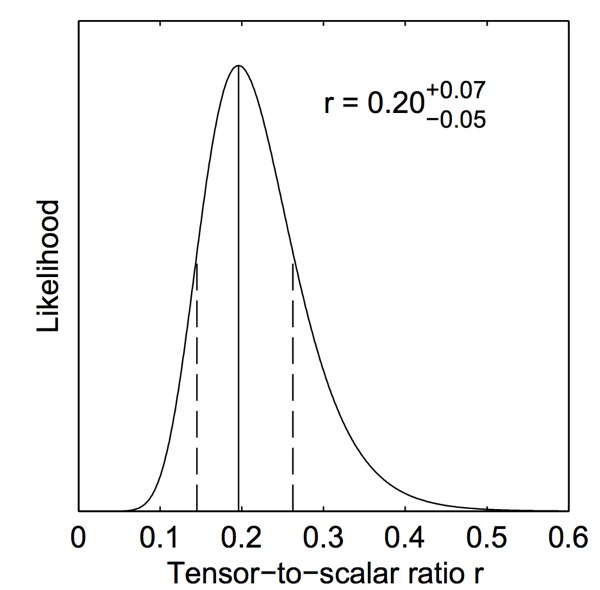
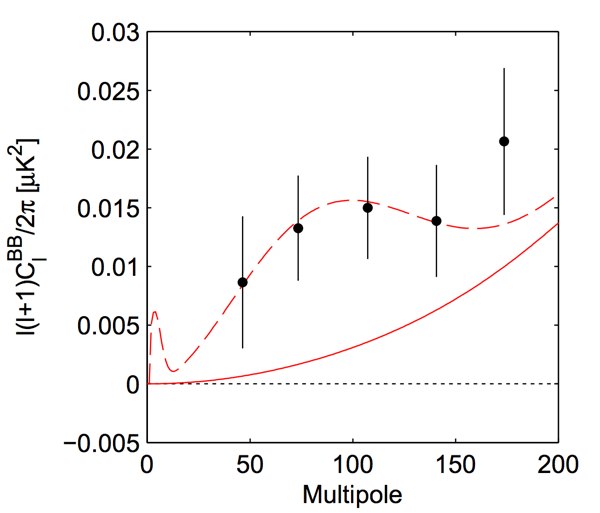
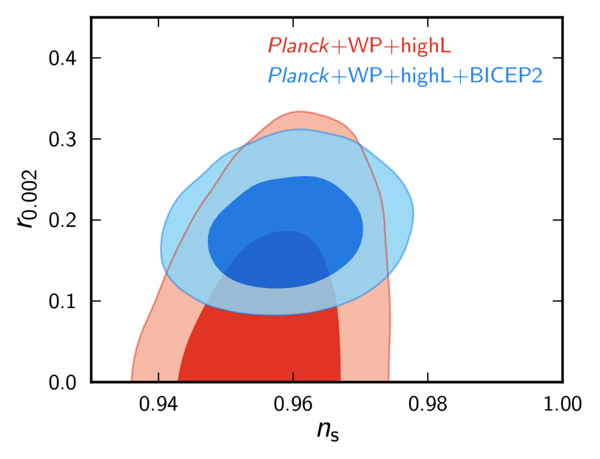
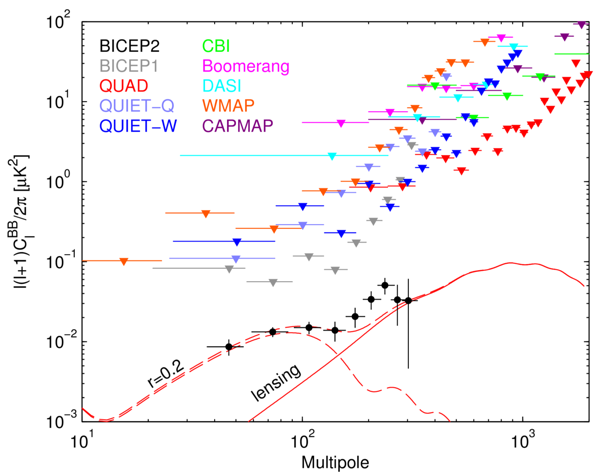
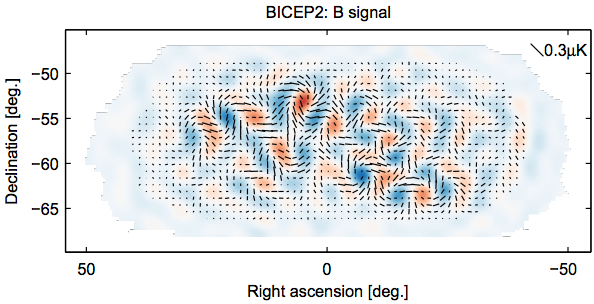
Pingback: Es brodelt in der Gerüchteküche | Volkssternwarte Hannover e.V.
Pingback: Allgemeines Live-Blog ab dem 16. März 2014 | Skyweek Zwei Punkt Null
Another mail just arrived from the CfA, clearly sounding like a significant positive detection:
“The Harvard-Smithsonian Center for Astrophysics (CfA) will host a press conference at 12:00 noon EDT (16:00 UTC) today to present the first results from the BICEP2 experiment, which measures B-mode polarization of the cosmic microwave background. This finding has major implications for our understanding of the first moments of the universe.
Participants:
— John Kovac, associate professor of astronomy at Harvard University
— Clem Pryke, associate professor at the University of Minnesota
— Jamie Bock, professor of physics at Caltech/JPL
— Chao-Lin Kuo, assistant professor at Stanford University/SLAC
— Marc Kamionkowski, professor of physics and astronomy at Johns Hopkins University”
Toast again to Dr. Einstein. Good to see science back in action confirming its theory through experiment and not more theory. 😉
I don’t have anything substantive to contribute…I’m just posting to get the email notifications of updates. But over on Jerry Coyne’s Web site, I just compared this (if it holds up) to the discovery of DNA, which I hope isn’t too hyperbolic….
b&
Thanks for this and, especially, yesterday’s post. Yes, their Fig. 13 (the 3rd one you had above) is the perfect comparison to your r/nS figure from yesterday.
They also nicely explained and qualified their choice of the “running” model (last two paragraphs of Section 11, right before Conclusions, bottom of p. 16 of the manuscript). But I had to laugh at the last sentence: “We anticipate a broad range of possibilities will be explored.” Guess they think some theorists will read it.
Do figures 10 and 13 mean that Starobinsky’s R^2 inflation is in trouble? Higgs inflation with strong non-minimal coupling to gravity (xi >>1) as well?
Pingback: Gravity Waves from Big Bang Detected: News Roundup
I watched this a few days ago. http://m.youtube.com/#/watch?v=e_4bMIqmV9U ‘How did the universe begin’ from UC Berkley. It covers a lot of the background. Lecturer also mentioned a project to directly detect gravitational waves. The detector measures distance to an accuracy equivalent to measuring the distance to the nearest star to a nanometre ( or was it a millimetre? ).
@Sean
Skimming the results paper, the tension between the BICEP2 estimate of r_0.002 and the published Planck results hinges on the question of whether one needs a “running spectral index” in the model. What is it, and why should we not expect index to be flat?
Pingback: ‘Smoking Gun’ Reveals How the Inflationary Big Bang Happened – NBCNews.com | Everyday News Update
Link
http://www.cfa.harvard.edu/news/news_conferences.html
not working for me (in Canada).
The LIGO experiment has been searching for gravity waves for years, but has come up empty. Any ideas of what’s to become of it, now?
Bob– LIGO is looking at a completely different wavelength, so there’s really very little comparison. And of course LIGO would be a direct detection of gravitational waves.
Another twist of this discovery — Standard model vacuum is unstable! — http://arxiv.org/abs/arXiv:1301.2846
Pingback: Spotted! The signature of our inflationary Universe?
Looks like you are using approximations at the Planck length to allow for inflation. Or, as I would put it, Uncertainty at less than the Planck length. What causes inflation, assuming it can squeeze into less than a Planck length to effectively separate mass? Rest mass conversion to energy?
Isn’t it better to use a mechanical cause rather than geometrical inflation for pure Isotropic expansion? The FLRW Metric is preserved by inflation, with G.R. operating around it in expanding spacetime. That means we live on a curved two-dimensional surface – which is improbable except by using a mathematical interpretation of reality.
Inventions using math are of no consequence except to the extent they are based on actual measurement. G.R. is useful in some ways and not others – mathematically useful but conceptually skewed. Rework G.R. and ad hoc inflation of unknown cause, and find a graviton mechanism. That might help.
What does this mean for the primordial Omega_GW today?
Are the GWs imprinted in the CMB B modes still in the universe today?
Andrei Linde gets the news…
http://sploid.gizmodo.com/witness-the-joy-of-the-man-who-predicted-todays-big-ba-1545834924
Question: Is this finding significant at the 5-sigma level? Ethan Seigel says no, it’s at the 2.7-signs level, so we should be more cautious with our conclusions. But the BICEP FAQ web page says its significant at the 5-sigma level? Anyone care to clarify this for me?
Two questions: Does this mean nobels for Kovak and Guth? Does this mean that the LISA experiment is no longer needed?
Pingback: Gravitational waves from inflation – Top Ten fun facts about BICEP2 and the results | Ecogirl & Cosmoboy's Blog
Pingback: Big News in Astrophysics: Primordial Gravitational Waves Detected | Physics Database
I demand a post from the blogosphere explaining the theory and especially practice of sigma bounds in physics. Mostly because I don’t understand whether this result is a) too low to be indicative, b) high enough to be indicative but too low to be certain, or c) actually high enough to be certain but physicists are being too demanding.
In short, I would like to Grok sigma levels.
Pingback: First Results From The BICEP2 CMB Telescope Announced re: Gravitational Waves in the Cosmic Microwave Background | Jeffrey Donenfeld